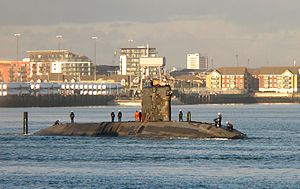|
Trafalgar-class submarine
The Trafalgar class was a class of nuclear-powered fleet submarines (SSNs) in service with the Royal Navy, and the successor to the Swiftsure class. Like the majority of Royal Navy nuclear submarines, all seven boats were constructed at Barrow-in-Furness shipyard, Cumbria. The class made up part of the Royal Navy's nuclear-powered ‘hunter-killer’ submarine force. The Trafalgar class was replaced by the larger and more capable Astute class, of which five are commissioned. The name Trafalgar refers to the Battle of Trafalgar fought between the Royal Navy and the combined fleets of France and Spain in 1805. DevelopmentThe Trafalgar class were designed in the early 1970s during the Cold War as a refinement of the preceding Swiftsure class. Including HMS Dreadnought, the Trafalgar class are the fifth class of nuclear-powered fleet submarines to enter service with the Royal Navy. The first of the class, HMS Trafalgar, was ordered on 7 April 1977 and completed in 1983. The last, HMS Triumph, was ordered on 3 January 1986 and completed in 1991. All seven boats of the class were built and completed by Vickers Shipbuilding and Engineering at the Barrow-in-Furness shipyard. In 1982, Jane's Fighting Ships recorded: "Estimated cost of fourth submarine £175 million including equipment and weapon system when fitted." In 1986, Jane's Fighting Ships recorded that the average cost for this class was £200 million at 1984–85 prices.[4] Potential exportIn 1987, the Canadian White Paper on Defence recommended the purchase of 10 to 12 Rubis- or Trafalgar-class submarines under technology transfer,[5] with the choice of the type of submarine due to be confirmed before summer 1988.[6] The goal was to build up a three-ocean navy and to assert Canadian sovereignty over Arctic waters.[7] The purchase was abandoned in April 1989 due to a growing budget deficit.[8] Operational serviceThe submarines of the class have seen service in a wide range of locations, most notably firing Tomahawk land-attack cruise missiles in anger at targets during conflicts in Afghanistan, Iraq and Libya. Three of the Trafalgar-class boats have been involved in such operations. In 2001 Trafalgar took part in Operation Veritas, the attack on Al-Qaeda and Taliban forces following the September 11 attacks in the United States, becoming the first Royal Navy submarine to launch Tomahawk cruise missiles against Afghanistan.[9] During April 2003, HMS Turbulent returned home flying the Jolly Roger after having launched thirty Tomahawk cruise missiles during the invasion of Iraq.[10] As part of the 2011 military intervention in Libya, HMS Triumph fired her Tomahawk cruise missiles on three occasions; first on 19 March,[11] then again on 20 March,[12][13] and finally on 24 March.[14] Her primary targets were Libyan air-defence installations around the city of Sabha.[15] Triumph returned to Devonport on 3 April 2011 flying a Jolly Roger adorned with six small Tomahawk axes to indicate the missiles fired by the submarine in the operation.[16] In 1993 Triumph sailed to Australia, covering a distance of 41,000 miles (66,000 km) whilst submerged and without any forward support. As of 2011, this still remained the longest solo deployment by any British nuclear submarine.[17] Service problemsIn 1998, Trenchant experienced a steam leak, forcing the crew to shut down the nuclear reactor. In 2000 a leak in the PWR1 reactor primary cooling circuit was discovered on Tireless, forcing her to proceed to Gibraltar on diesel power.[18] The fault was found to be due to thermal fatigue cracks, requiring the other Trafalgar-class boats, and some of the remaining Swiftsure-class boats, to be urgently inspected and if necessary modified.[18] In 2013 the Defence Nuclear Safety Regulator reported that the reactor systems were suffering increasing technical problems due to ageing, requiring effective management. An example was that Tireless had had a small radioactive coolant leak for eight days in February 2013.[19] Characteristics As a refinement of the preceding Swiftsure class, the design of the Trafalgar class bears some similarity, including its internal layout and the Rolls-Royce PWR1 Core 3. However some improvements over the Swiftsure class include its reduced acoustic signature, which is due to the hull being covered in anechoic tiles which are designed to absorb sound rather than reflect it, making the boats quieter and more difficult to detect with active sonar. A pumpjet propulsion system is also used from boat 2 onward, rather than a conventional propeller.[20] The Trafalgar class are 85.4 m (280 ft 2 in) long,[2] have a beam of 9.8 m (32 ft 2 in),[2] a draught of 9.5 m (31 ft 2 in)[2] and a dived displacement of 5,300 tonnes (5,200 long tons).[2] Each boat has a complement of 130.[2] Like all Royal Navy submarines, the Trafalgar class have strengthened fins and retractable hydroplanes, allowing them to surface through thick ice. Four boats of the class — Torbay, Trenchant, Talent and Triumph — have been fitted with the Sonar 2076 system. Beginning in 2014, the last four boats of the class underwent a communications package upgrade.[2] The Trafalgar class is equipped with five 21-inch (533 mm) torpedo tubes with accommodation for a mixture of up to 30 weapons:[2] The Tomahawk missiles are capable of hitting a target to within a few metres, to a range of 1,000 miles (1,600 km).[21] Ostensibly, the submarines use the same steering column as was used in the Wellington bombers of the Second World War.[22] Boats of the classInitially, the last five boats of the Trafalgar class were to be replaced by the 'Future Fleet Submarine' programme, however this was effectively cancelled in 2001. The Astute class are replacing the Trafalgar class.[23]
In fictionIn June 2019, ITV commissioned a six-part thriller to be set aboard a fictional Trafalgar-class submarine, HMS Tenacity.[29] However, production on the series was paused in 2020, before being dropped all together by November 2021.[30] See also
Notes
References
Bibliography
External linksWikimedia Commons has media related to Trafalgar class submarines.
|
||||||||||||||||||||||||||||||||||||||||||||||||||||||||||||||||||||||||||||||||||||||||||||||||||||||||||||
